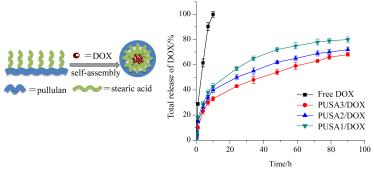1 Xiong, X. B.; Ma, Z. S.; Lai, R.; Lavasanifar, A. Biomaterials2010, 31, 1.  2 Zhang, H.-T.; Li, F.; Yi, J.; Gu, C.-H.; Fan, L.; Qiao, Y.-B.; Tao, Y.-C.; Cheng, C.; Wu, H. Eur. J. Pharm. Sci. 2011, 42,517. 3 Wang, Y.; Wang, Y.-Q.; Xiang, J.-N.; Yao, K.-T. Biomacromolecules2010, 11, 3531. 2 Zhang, H.-T.; Li, F.; Yi, J.; Gu, C.-H.; Fan, L.; Qiao, Y.-B.; Tao, Y.-C.; Cheng, C.; Wu, H. Eur. J. Pharm. Sci. 2011, 42,517. 3 Wang, Y.; Wang, Y.-Q.; Xiang, J.-N.; Yao, K.-T. Biomacromolecules2010, 11, 3531.  4 Xiao, K.; Luo, J. T.; Li, Y. P.; Lee, J. S.; Fung, G.; Lam, K. S. J. Controlled Release 2011, 155, 272. 4 Xiao, K.; Luo, J. T.; Li, Y. P.; Lee, J. S.; Fung, G.; Lam, K. S. J. Controlled Release 2011, 155, 272.  5 Zhou, Y.-Y.; Du, Y.-Z.; Wang, L.; Yuan, H.; Zhou, J.-P.; Hu, F. Q. Int. J. Pharm. 2010, 393, 143. 6 Leather, T. D. Appl. Microbiol. Biotechnol. 2003, 62, 468. 5 Zhou, Y.-Y.; Du, Y.-Z.; Wang, L.; Yuan, H.; Zhou, J.-P.; Hu, F. Q. Int. J. Pharm. 2010, 393, 143. 6 Leather, T. D. Appl. Microbiol. Biotechnol. 2003, 62, 468.  7 Chen, M.-M.; Liu, Y.; Yang, W.-Z.; Li, X.-M.; Liu, L.-R.; Zhou, Z.-M.; Wang, Y.-S.; Li, R.-F.; Zhang, Q.-Q. J. Carbohydr. Polym. 2011, 84, 1244. 7 Chen, M.-M.; Liu, Y.; Yang, W.-Z.; Li, X.-M.; Liu, L.-R.; Zhou, Z.-M.; Wang, Y.-S.; Li, R.-F.; Zhang, Q.-Q. J. Carbohydr. Polym. 2011, 84, 1244.  8 Choi, K. Y.; Chung, H.; Min, K. H.; Yoon, H. Y.; Kim, K.; Park, J. H.; Kwon, I. C.; Jeong, S. Y. Biomaterials 2010, 31,106. 8 Choi, K. Y.; Chung, H.; Min, K. H.; Yoon, H. Y.; Kim, K.; Park, J. H.; Kwon, I. C.; Jeong, S. Y. Biomaterials 2010, 31,106.  9 Dulong, V.; Mocanu, G.; Cerf, D. L. J. Colloid Polym. Sci.2007, 285, 1085. 9 Dulong, V.; Mocanu, G.; Cerf, D. L. J. Colloid Polym. Sci.2007, 285, 1085.  10 Yang, W.-H.; Chen, H.-L.; Gao, F.-P.; Chen, M.-M.; Li, X.-M.; Zhang, M.-M.; Zhang, Q.-Q.; Liu, L.-R.; Jiang, Q.; Wang, Y.-S. Curr. Nanosci. 2010, 6(3), 298. 11 Hu, F.-Q.; Liu, L.-N.; Du, Y.-Z.; Yuan, H. Biomaterials2009, 30, 6955. 10 Yang, W.-H.; Chen, H.-L.; Gao, F.-P.; Chen, M.-M.; Li, X.-M.; Zhang, M.-M.; Zhang, Q.-Q.; Liu, L.-R.; Jiang, Q.; Wang, Y.-S. Curr. Nanosci. 2010, 6(3), 298. 11 Hu, F.-Q.; Liu, L.-N.; Du, Y.-Z.; Yuan, H. Biomaterials2009, 30, 6955.  12 Sallustio, S.; Galantini, L.; Gente, G.; Masci, G.; Mesa, C. L. J. Phys. Chem. B 2004, 108, 18876. 12 Sallustio, S.; Galantini, L.; Gente, G.; Masci, G.; Mesa, C. L. J. Phys. Chem. B 2004, 108, 18876.  13 Scomparin, A.; Salmaso, S.; Bersani, S.; Saatchi-Fainaro, R.; Calceti, P. Eur. J. Pharm. Sci. 2011, 42, 547. 14 Gao, F.-P.; Zhang, H.-Z.; Liu, L.-R.; Wang, Y.-S.; Jiang, Q.; Yang, X.-D.; Zhang, Q.-Q. J. Carbohydr. Polym. 2008,71, 606. 13 Scomparin, A.; Salmaso, S.; Bersani, S.; Saatchi-Fainaro, R.; Calceti, P. Eur. J. Pharm. Sci. 2011, 42, 547. 14 Gao, F.-P.; Zhang, H.-Z.; Liu, L.-R.; Wang, Y.-S.; Jiang, Q.; Yang, X.-D.; Zhang, Q.-Q. J. Carbohydr. Polym. 2008,71, 606.  15 Acharya, S.; Dilnawaz, F.; Sahoo, S. K. Biomaterials 2009,30, 5737. 15 Acharya, S.; Dilnawaz, F.; Sahoo, S. K. Biomaterials 2009,30, 5737.  16 Zheng, C.; Xu, J.; Yao, X.-P.; Xu, J.; Qiu, L.-Y. J. Colloid. Interface Sci. 2011, 355, 374. 16 Zheng, C.; Xu, J.; Yao, X.-P.; Xu, J.; Qiu, L.-Y. J. Colloid. Interface Sci. 2011, 355, 374.  17 Zhang, C.; Zhao, L.-Q.; Dong, Y.-F.; Zhang, X.-Y.; Ji, L.; Chen, Z.-H. Eur. J. Pharm. Biopharm. 2010, 76, 10. 17 Zhang, C.; Zhao, L.-Q.; Dong, Y.-F.; Zhang, X.-Y.; Ji, L.; Chen, Z.-H. Eur. J. Pharm. Biopharm. 2010, 76, 10.  18 Shi, Y. P.; Chen, B.-Q.; Ma, J.; Liu, Y.-M.; Li, C.-W. Acta Chim. Sinica 2011, 69, 2561 (in Chinese). (史艳萍, 陈宝泉, 麻静, 刘玉明, 李彩文, 化学学报,2011, 69, 2561.) 19 Zhou, S.-S.; Xue, X.; Jiang, B.; Lu, C.-H.; Tian, Y.-P.; Jiang, M.-H. Acta Chim. Sinica 2011, 69, 2335 (in Chinese). (周双生, 薛璇, 姜波, 鲁传华, 田玉鹏, 蒋明华, 化学学 报, 2011, 69, 2335.) 20 Naozumi, T.; Mitsuhiro, S. J. Carbohydr. Polym. 2006, 63,476. 18 Shi, Y. P.; Chen, B.-Q.; Ma, J.; Liu, Y.-M.; Li, C.-W. Acta Chim. Sinica 2011, 69, 2561 (in Chinese). (史艳萍, 陈宝泉, 麻静, 刘玉明, 李彩文, 化学学报,2011, 69, 2561.) 19 Zhou, S.-S.; Xue, X.; Jiang, B.; Lu, C.-H.; Tian, Y.-P.; Jiang, M.-H. Acta Chim. Sinica 2011, 69, 2335 (in Chinese). (周双生, 薛璇, 姜波, 鲁传华, 田玉鹏, 蒋明华, 化学学 报, 2011, 69, 2335.) 20 Naozumi, T.; Mitsuhiro, S. J. Carbohydr. Polym. 2006, 63,476.  |
